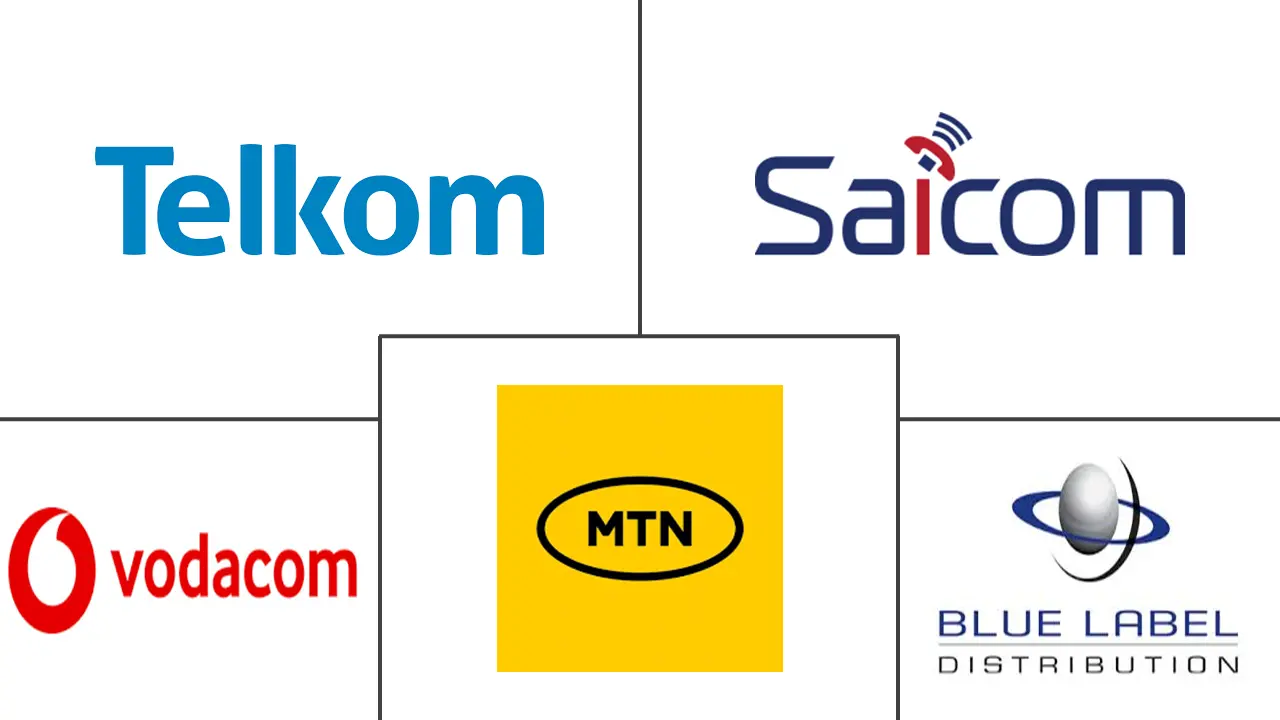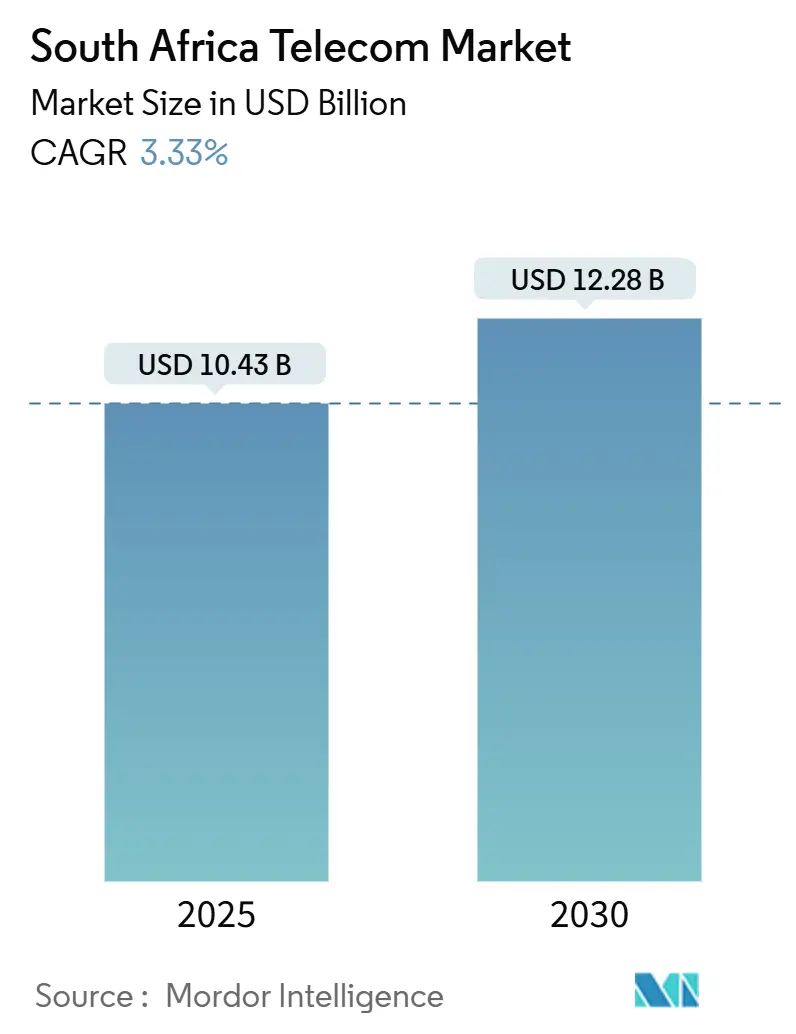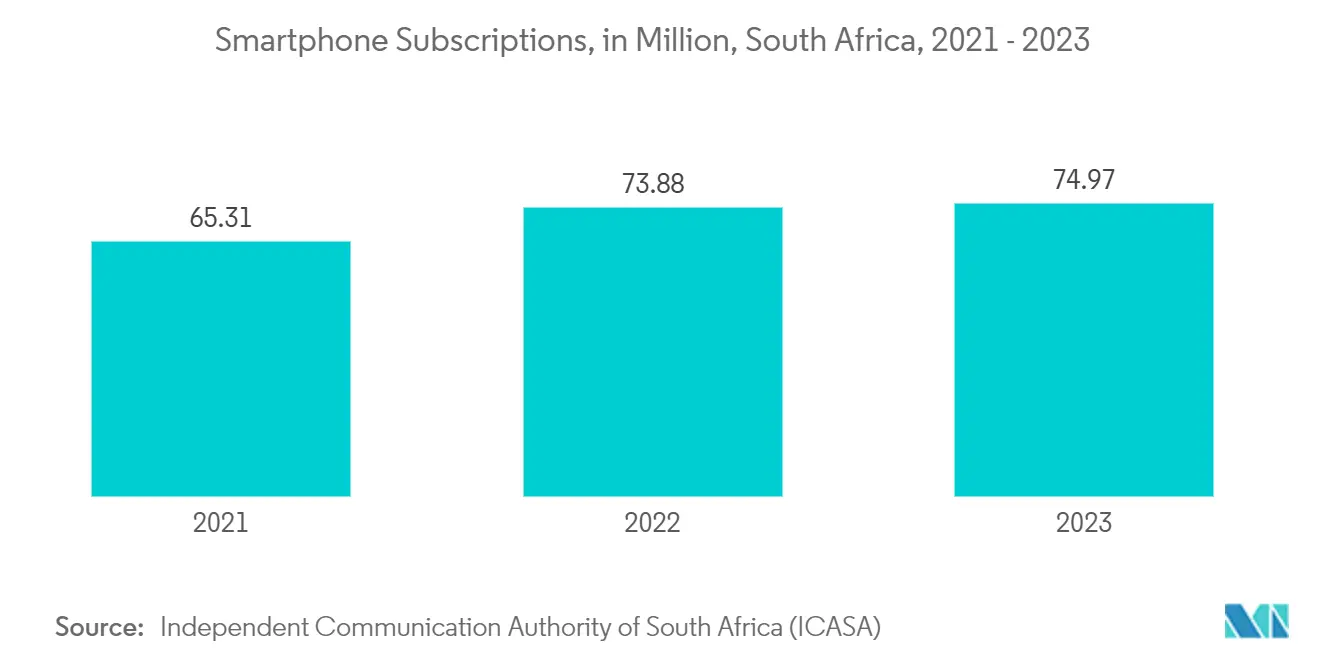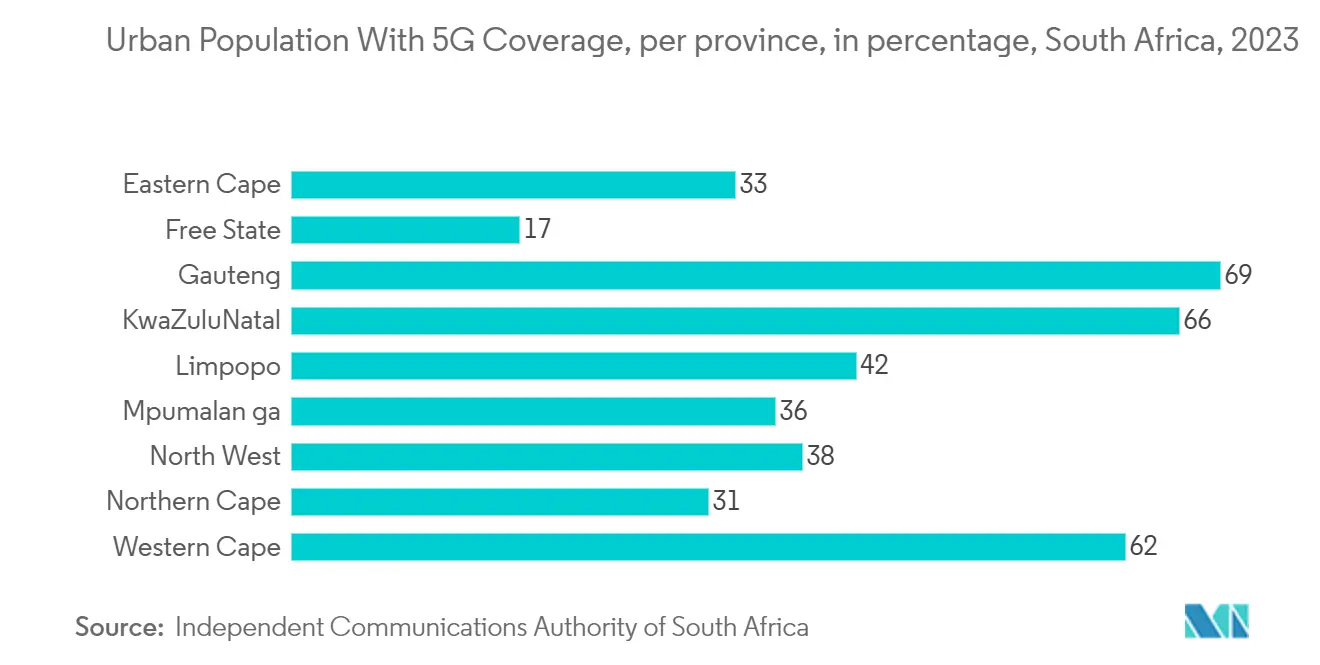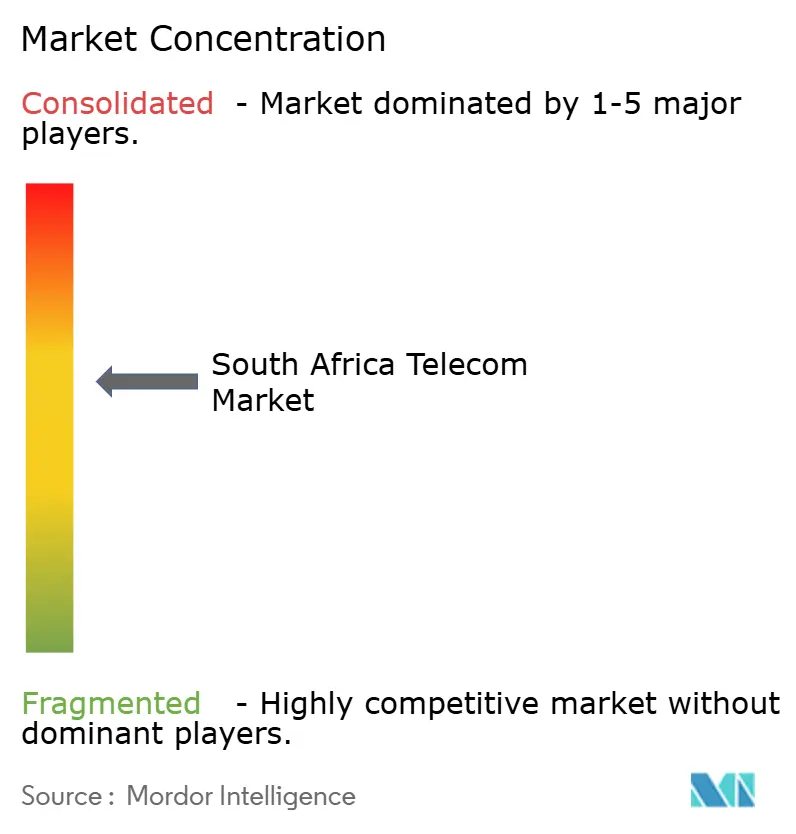South Africa Telecom Market Analysis
The South Africa Telecom Market size is estimated at USD 10.43 billion in 2025, and is expected to reach USD 12.28 billion by 2030, at a CAGR of 3.33% during the forecast period (2025-2030).
- South Africa's telecom sector is driven by an increasing urban population and the prevalent use of cell phones supporting 3G, 4G, and 5G services. Additionally, the rising adoption of the Internet of Things (IoT), leveraging both wired and wireless internet, is poised to bolster the telecom industry's expansion during the forecast period.
- Government initiatives to expand internet access across the country would create an opportunity for market players to enhance their services or develop new services to meet customer needs.
- For instance, in April 2024, South Africa's Minister of Communications and Digital Technologies unveiled a plan to extend internet access to 5.5 million households in rural areas and townships over the next three to four years. This initiative seeks to close the digital gap in a nation where, as of September 2023, a mere 10% of households enjoyed internet connectivity. As South Africa and the broader continent chart their digital future, bolstering internet access and propelling AI development stand out as pivotal goals.
- Security threats and private data leaks pose significant challenges to the South African telecom market, hindering its growth. As the telecom industry rapidly digitalizes, it inadvertently broadens its attack surface, making it more susceptible to cybercriminal breaches. Such breaches jeopardize user data, encompassing sensitive personal and financial details. Consequently, these incidents diminish consumer trust in telecom operators, risking a downturn in both customer retention and acquisition.
- Foreign Direct Investment (FDI) frequently enhances telecommunications infrastructure. Typically, foreign investors introduce both capital and advanced technology. This infusion facilitates the expansion of networks, particularly in rural areas, and elevates the overall quality of connectivity and services.
South Africa Telecom Market Trends
Data and Messaging Services Witness Major Growth
- The data and messaging services segment in South Africa's telecom market encompasses mobile and fixed data solutions, including internet access, broadband services, and messaging. It supports communication, entertainment, and business needs through reliable connectivity. This segment is driven by increasing smartphone penetration and demand for high-speed internet. It also includes value-added messaging platforms for personal and enterprise use.
- Mobile penetration, affordable data plans, and technological advancements have fueled significant growth in the market. As smartphone subscriptions and data packages become more cost-effective, consumers increasingly turn to mobile data for communication, entertainment, and online services. For instance, according to the Independent Communication Authority of South Africa (ICASA), the number of smartphone subscriptions in 2023 is 74.97 million.
- In August 2024, Rain unveiled a new offering on rainMobile, granting customers 2GB of data, 60 minutes of talk time, and 100 SMS messages monthly. Priced at R165 on a month-to-month basis, the plan operates on Rain's national 4G network. Highlighting its flexibility, the offering requires no long-term contracts, freeing users from fixed commitments. With this initiative, Rain bolsters its market position, presenting a competitive and affordable solution tailored to the evolving demands of South African mobile users.
- In May 2024, Vox, an internet service provider, rolled out its 5G service, aiming to deliver high-speed connectivity and top-notch performance. The new 5G towers can connect up to 10,000 users, a significant leap from the 200 to 400 connections on 4G, and boast speeds at least 10 times faster. With a widespread network of 5G towers nationwide, Vox is offering South Africans an affordable, next-generation connectivity solution poised to elevate both consumer and business service delivery. Their competitive pricing and service delivery ensure customers fully experience the remarkable speeds and capabilities of 5G on a robust, reliable network.
Mobile Network Witness Major Growth
- Mobile network services refer to telecommunications services that enable voice communication, text messaging, internet access, and data transfer through mobile networks such as 4G and 5G. These services are provided by mobile network operators to individuals and businesses. In South Africa, mobile network services have become integral to connectivity, offering essential services that fuel economic activities, entertainment, and social interactions. Companies operating in the country expand their business as the mobile network continuously evolves.
- Moreover, As per the Independent Communications Authority of South Africa, Gauteng (69%) and KwaZulu-Natal (66%) lead in 5G coverage, indicating strong investment in high-density urban areas. This trend underscores opportunities for mobile network expansion in underserved regions, driving market growth.
- For instance, in November 2024, technology group e& entered into a strategic partnership with WIOCC, known as Africa’s Carriers’ Carrier, to boost the growth of the hyperscaler ecosystem across Africa. This collaboration will further strengthen e&’s presence in Africa, in addition to its global reach spanning 38 markets in Asia, the Middle East, Africa, and Central & Eastern Europe. This partnership aims to enhance mutual capabilities and open up new avenues for growth in underserved and emerging markets across various parts of Africa, including the eastern and southern regions where the majority of hyperscalers operate.
- In August 2024, IHS Holding Limited and MTN Group renewed and extended communications infrastructure deals in Nigeria, as well as completing the renewal of all contracts across IHS Towers-MTN markets recently. With the commercial relationship now firmly established for the next decade, they will now work constructively to find a mutually agreeable resolution to governance issues previously raised. The companies announced the agreement to renew and extend all Nigerian tower Master Lease Agreements until December 2032.
- The contracts include new financial terms that provide what the parties believe to be a more sustainable split between local and foreign currency. With this, IHS Towers and MTN Group have now completed the renewal of approximately 26,000 MTN tenancies on IHS Towers infrastructure across six African markets – Nigeria, Rwanda, Côte d’Ivoire, Cameroon, Zambia, and South Africa.
South Africa Telecom Industry Overview
The size of the network and coverage determines the size of the market share. In the telecommunication sector, all aspects of rivalry, including price discounting, introducing new products, service improvements, and advertising campaigns, brand identity, powerful competitive strategy, and distribution control, play an essential role.
The brand identity is highly associated with the companies that have a major influence in this market. Key vendors like Vodacom South Africa, Telkom SA SOC Limited, MTN GROUP LTD, and others are synonymous with providing telecom services; therefore, long-standing players are expected to have the upper hand.
Further, major telecom players have a moderately high level of market penetration and are continuously expanding their telecom services in rural areas of the country, offering them an advantage in the competition. For example, Cell C, a mobile operator in South Africa, is in talks with low-Earth-orbit (LEO) satellite providers to deliver affordable broadband services with a focus on rural regions.
South Africa Telecom Market Leaders
-
Vodacom South Africa (Vodacom Group)
-
Telkom SA SOC Limited.
-
Mobile Telephone Networks (PTY) LTD (MTN Group Limited)
-
Cell C Limited (Blue Label Telecoms)
-
Saicom Voice Services (Pty) Ltd
- *Disclaimer: Major Players sorted in no particular order
South Africa Telecom Market News
- November 2024: MTN South Africa and tech giant Huawei successfully conducted the nation's first 5.5G network trial at MTN's Johannesburg headquarters. This trial highlights the potential for telecom operators to stay ahead of technological advancements and position themselves as leaders in next-generation network solutions, which can attract both enterprise and consumer markets.
- September 2024: MTN South Africa, in collaboration with ZTE Corporation, unveiled Africa's inaugural 5G ultra-range maritime coverage in Mossel Bay, Western Cape. This pioneering move represents a unique opportunity for the telecom market to extend its services to maritime sectors, enhance connectivity for tourism, and support economic activities such as fishing, thereby diversifying its market reach.
South Africa Telecom Industry Segmentation
Telecom or Telecommunication is the long-range transmission of information by electromagnetic means. Several factors, including an increasing demand for 5G, likely drive the adoption of telecom services in South Africa.
The South Africa telecom market is segmented by services (voice services [wired and wireless], data and messaging services, and OTT and PayTV services) and telecom connectivity (fixed network [fixed broadband internet services, fixed voice services], mobile network). The market sizes and forecasts are provided in terms of value (USD) for all the above segments.
| Overall Telecom Revenue | Telecom Subscribers | ||||
| Average Revenue Per User | |||||
| Telecom Services | Voice Services | Wired | |||
| Wireless | |||||
| Data and Messaging Services | |||||
| OTT and PayTV Services | |||||
| Telecom connectivity | Fixed Network | Fixed Broadband Internet Services | Market Overview Broadband Services (Fixed and Wireless) | Seasonality Trends in Consumer Demands in a Year | |
| Evolution of Adoption of Broadband Services in South Africa in the Last 5 Years | |||||
| Summary of Porter's Five Forces Analysis | |||||
| Market Size and Growth Projections of Fixed Broadband Internet Services in South Africa, in Terms of Subscription Count | |||||
| Heatmap of Current Fixed Broadband Concentration Across Major Provinces | |||||
| Breakdown of the Fixed Broadband Industry Based on Subscriptions for FTTH & DSL | |||||
| Current Ranking of The Major Broadband Providers in South Africa, Based on Subscription Count | |||||
| Vendor Benchmarking Analysis | |||||
| Opportunities for FWA Broadband | |||||
| Fixed Voice Services | |||||
| Mobile Network | |||||
South Africa Telecom Market Research Faqs
How big is the South Africa Telecom Market?
The South Africa Telecom Market size is expected to reach USD 10.43 billion in 2025 and grow at a CAGR of 3.33% to reach USD 12.28 billion by 2030.
What is the current South Africa Telecom Market size?
In 2025, the South Africa Telecom Market size is expected to reach USD 10.43 billion.
Who are the key players in South Africa Telecom Market?
Vodacom South Africa (Vodacom Group), Telkom SA SOC Limited., Mobile Telephone Networks (PTY) LTD (MTN Group Limited), Cell C Limited (Blue Label Telecoms) and Saicom Voice Services (Pty) Ltd are the major companies operating in the South Africa Telecom Market.
What years does this South Africa Telecom Market cover, and what was the market size in 2024?
In 2024, the South Africa Telecom Market size was estimated at USD 10.08 billion. The report covers the South Africa Telecom Market historical market size for years: 2019, 2020, 2021, 2022, 2023 and 2024. The report also forecasts the South Africa Telecom Market size for years: 2025, 2026, 2027, 2028, 2029 and 2030.
Our Best Selling Reports
South Africa Telecom Industry Report
The Telecommunications Sector in South Africa is on a significant upswing, fueled by advancements in mobile, fixed voice, fixed broadband, and pay-TV services. This surge is credited to the nation's efforts in enhancing its telecommunications infrastructure, notably through 4G and 5G network expansions. A notable shift is seen as consumers move from traditional telephony to Voice over Internet Protocol (VoIP) and Over-the-Top (OTT) services, underscoring a high demand for speedy internet and data services. The mobile segment is transforming, with an increase in smartphone subscriptions driven by telecommunications companies in South Africa offering diverse data and voice packages. These companies are also evolving in a competitive landscape, aiming to improve service delivery and extend coverage, aligning with national objectives to elevate broadband speeds and accessibility, and fostering a digitally inclusive society. The regulatory framework is adapting to support a competitive market that encourages innovation. According to Mordor Intelligence™ Industry Reports, the market is experiencing growth in share, size, and revenue, with a detailed analysis available as a free PDF download, providing a forecast outlook and historical overview of telecommunications in South Africa.

